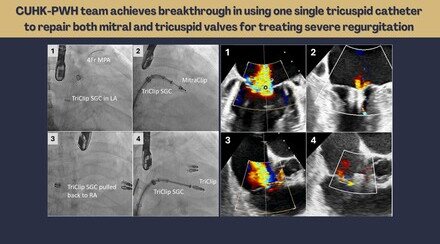Global study involving CUHK finds Asian patients with degenerative mitral regurgitation show signs of undertreatment and excess mortality compared with European-American counterparts
Mitral regurgitation is a common heart valve disease, and patients with severe cases of the condition may require mitral valve repair surgery. Most studies on degenerative mitral regurgitation (DMR) clinical outcomes and interventional thresholds have been conducted in Europe and the U.S., and little is known about Asian patients. As a result, The Chinese University of Hong Kong (CUHK)’s Faculty of Medicine (CU Medicine) collaborated with international experts in valvular heart disease to compare the presentation, management and clinical outcomes of Asian patients with those of Europeans and Americans. The findings have been published in Journal of the American College of Cardiology: Asia.
Results showed the two groups presented similar DMR lesions and severity, but Asian patients were younger and had fewer symptoms. More importantly, Asians’ smaller cardiac cavities due to their average smaller body size may result in underestimation of volume overload from imaging. And there was less mitral intervention in Asian patients that incurred subsequent excess mortality compared with the European-American cohort. Researchers suggest imaging and cultural specificity are capable of improving DMR outcomes worldwide.
Failure to account for body size results in worse clinical outcomes
Mitral regurgitation (MR) refers to failure of mitral valve leaflet coaptation that causes blood backflow from the left ventricle to the left atrium. It is a common valvular heart disease worldwide, which is present in about 2-3% of the general population. DMR, which is responsible for 50-60% of MR, is a variety of the condition caused by valvular or chordal degeneration, a progressive disease associated with excess mortality and morbidity when severe.
The international research team gathered two large populations of patients with DMR due to flail mitral leaflets from the Hong Kong’s Prince of Wales Hospital in Hong Kong and the National Heart Centre Singapore, forming the Asian study cohort of 737 patients. They analysed and compared them to a large cohort of 682 patients from the Mitral Regurgitation International Database, the largest international multicentre European and American institution registry, with the same DMR causes and similar socio-economic backgrounds.
The key results are as follow (Please refer to Table 1 for data):
- Profound imaging similarities were found between the two cohorts, in terms of DMR severity, mechanism (flail segment) of DMR, and consequences in pulmonary hypertension.
- Asian patients were younger, with different distributions of risk factors and associated conditions.
- Importantly, imaging showed striking baseline morphometric differences. Asian patients had smaller body sizes and considerably smaller absolute left atrium and left ventricular dimensions, which are far from DMR guideline-based thresholds. Nevertheless, after normalising to body-surface area, the indexed left atrium and left ventricular sizes were in fact larger in Asian patients than the European-American cohort, demonstrating volume overload severity.
- In terms of treatment effectiveness, repair interventions predominate similarly and, when performed, provide similar survival benefits in the two cohorts. However, disease management was very different – Asian patients were observed with considerably less and delayed mitral interventions, compared with European-American group. Consequently, the outcomes were affected. The mortality was increased to 40% over ten years in Asian compared with 20% in European-American group.
Table 1: Major clinical outcomes between Asian cohort and European-American cohort
| Asian cohort | European-American cohort |
|---|---|---|
Average age | 61 years old | 66 years old |
Median time from diagnosis to intervention | 42 days | 24 days |
Proportion of patients received mitral valve interventions 1 year after diagnosis | 55% | 77% |
Proportion of patients received mitral valve interventions after diagnosis during the study | 65% | 79% |
Dr Maurice Enriquez-Sarano
Dr Maurice Enriquez-Sarano, co-corresponding author of the study, Senior Research Scientist of Minneapolis Heart Institute and Cardiology Specialist in the Department of Cardiovascular Medicine at Mayo Clinic, said, “The current mitral repair surgery criterion is based on the absolute dimension of left atrium and left ventricle, without considering the body size in various ethnic groups. Our study showed the extent of cardiac remodelling related to DMR was significantly underestimated in Asian patients, highlighting the need to account for body size. From multivariable analysis and propensity-score matching, adjusting for and balancing clinical characteristics, we confirmed both undertreatment and excess mortality in Asian patients. We suggest DMR imaging and management should account for these specificities and strive towards early mitral interventions and optimal outcomes in patients with DMR worldwide.”

Professor Alex Lee
Professor Alex Lee Pui-wai, co-corresponding author of the study and Professor in the Department of Medicine and Therapeutics at CU Medicine, said, “In this study, Asian patients were found to be of a younger age but the underlying reason for that was uncertain; it could be biological or referral-related. Future genetic and population-based studies should evaluate whether the development of myxomatous mitral degeneration is different in various populations and whether management modulations are in order.”









